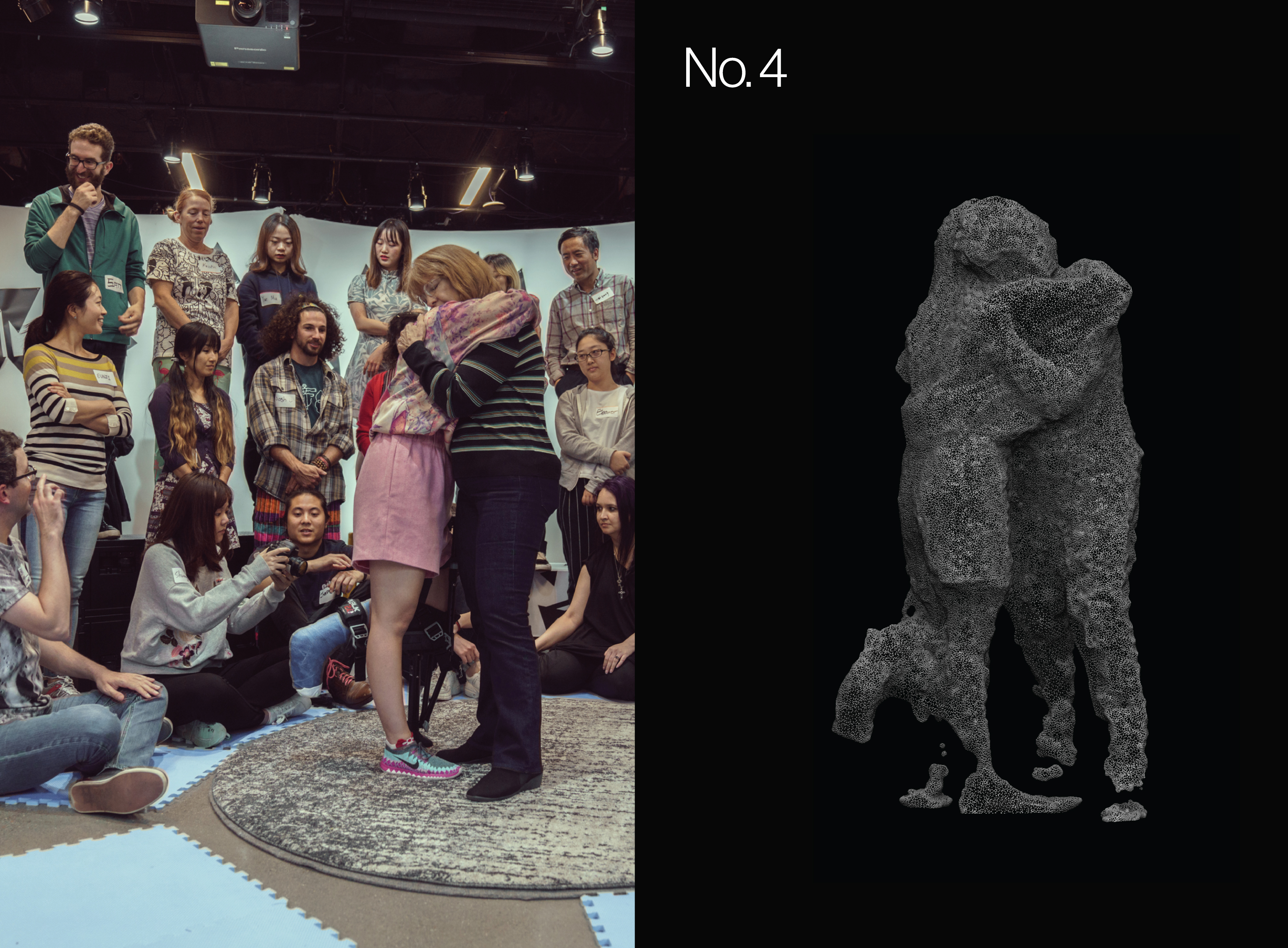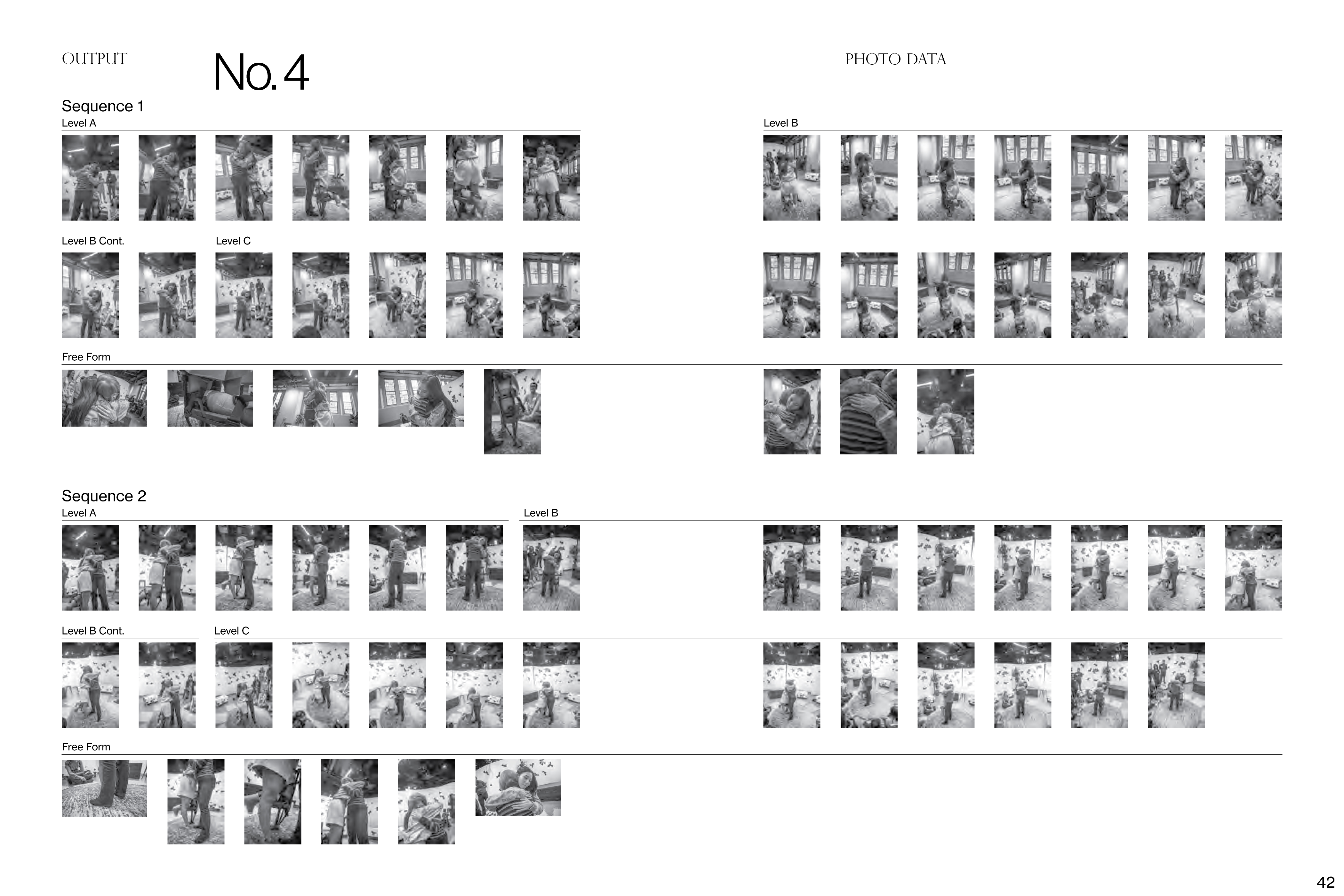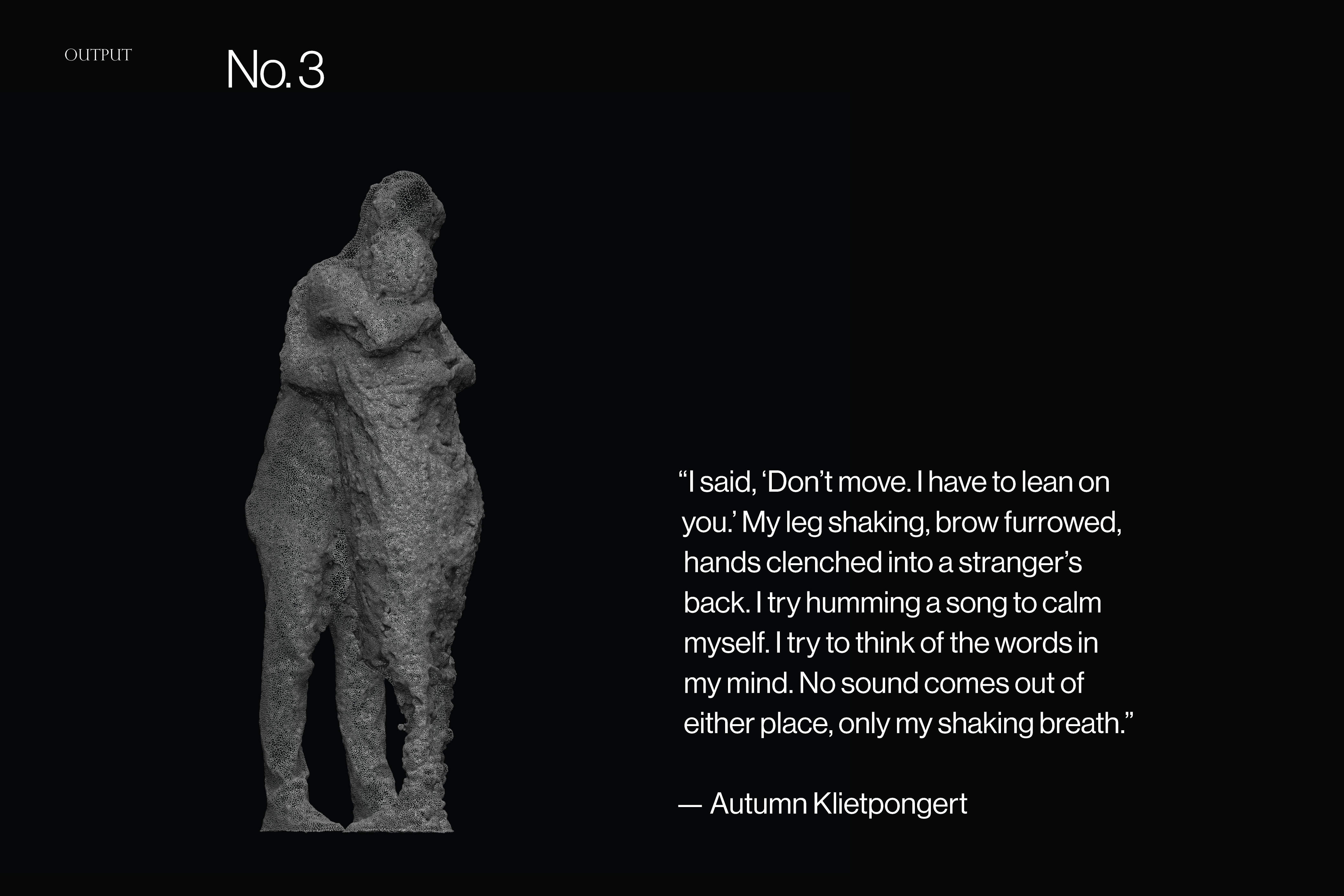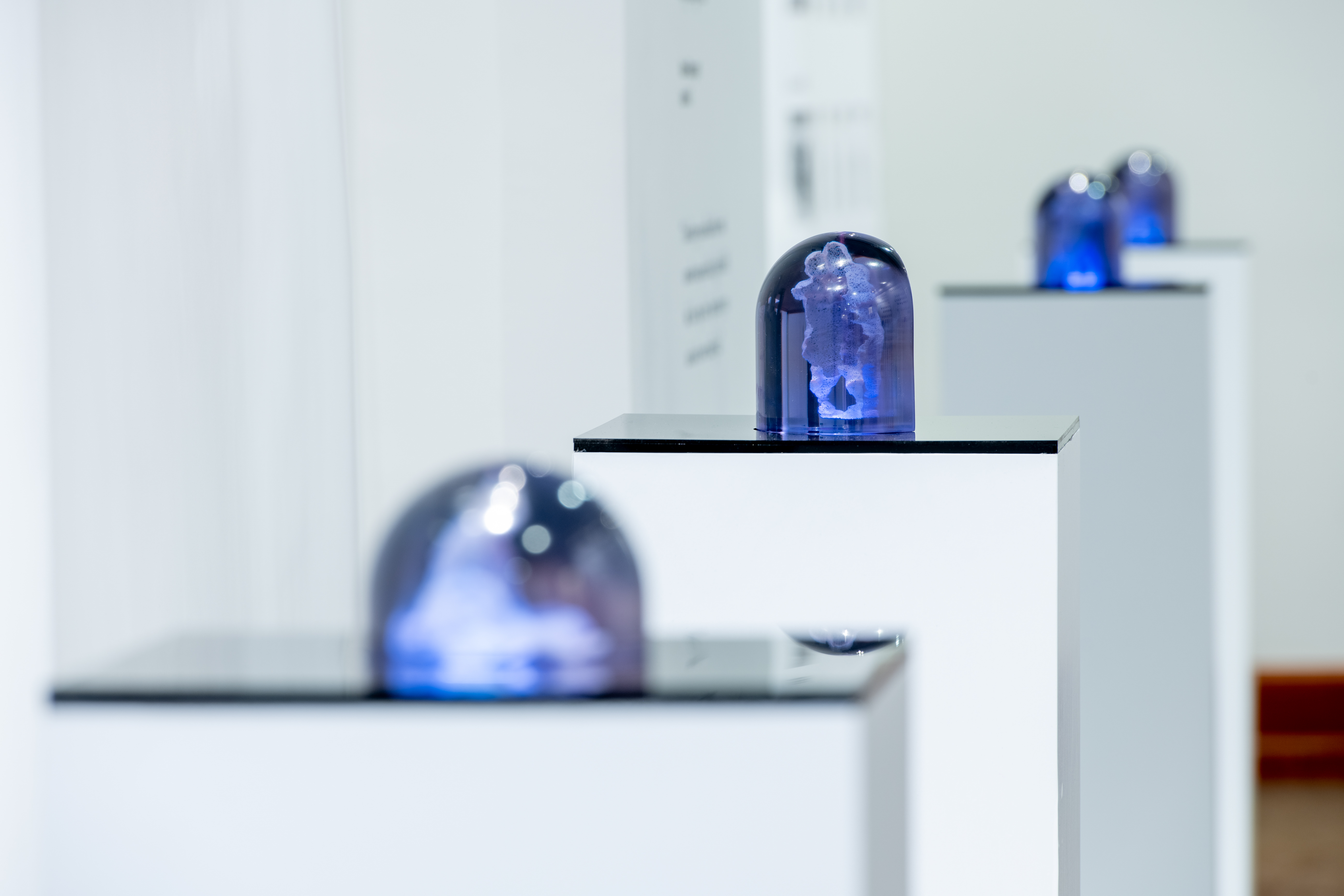Knowing Together is an experiment in collaborative photogrammetry and the expression of embodied
experience in three-dimensional art. This experiment was designed to probe beyond the typical limits
of photogrammetry, a technique for creating 3D models by combining multiple photographs of an
object from different angles. Our initial aim was to introduce new complexity into the practice of
photogrammetry. By assembling a group of collaborators and asking them to produce 3D images of a
shared experience, we attempted to capture this experience over time and preserve the creative process in
static digital objects and a collection of source materials displayed together in a gallery.
Another aim of this project has been to test the expressive limits of 3D scanning techniques using critical rather than conventional methods. To see an object from every angle at any level of detail may seem to promise unprecedented expressive potential. Photogrammetry bridges the domains of photography and sculpture, reflecting the perennial artistic drive toward mimesis—a convincing imitation of the real world, crafted so finely that its artifice could figure in a convincing reconstruction of the world. For decades, museums have treated photogrammetry as a means of creating three-dimensional records of items from their collections. These objects are frozen in time, rendered as immaterial ideal forms, sometimes even used as building blocks for other applications.
Knowing Together inverts this logic. Beginning with a workshop designed to create an immersive experience for participants, we explored how a group of people sharing this experience could together facilitate something more expressive and personally meaningful through photogrammetry than mere photorealism. Instead of appealing to the novel affordances of this technology and creating work for presentation to individual spectators, we designed a collective experience to be captured and modeled through unconventional use of this technology.
![]() In photogrammetry, the image does not convey the perspective of a single observer, but the totality of viewpoints
surrounding the object. Our collaborative approach to photogrammetry treats each participant as the source of a single
perspective among the many needed to construct a synoptic image.
In photogrammetry, the image does not convey the perspective of a single observer, but the totality of viewpoints
surrounding the object. Our collaborative approach to photogrammetry treats each participant as the source of a single
perspective among the many needed to construct a synoptic image.
The focal point of Knowing Together was a daylong workshop centered on intimacy and vulnerability, in which pairs of strangers platonically embraced for several minutes at a time. As each pair stood in the center of a circle formed by the remaining group members, participants took turns snapping photos with a digital single-lens reflex (SLR) camera. When combined, these photos yielded a 3D image of each embrace. For most participants, this was their first time practicing photogrammetry.
During each embrace, a microphone placed between subjects captured sounds that would not be audible otherwise, such as their breath, heartbeat and whispered exchanges about topics like consent and posture. After the workshop, participants were asked for written reflections on the experience, and selections were posted on the gallery walls alongside source photos.
We selected seven groups, mostly pairs, to serve as subjects of the sculptures. Some were already acquainted, a few were family, but most were strangers. Central to the experience was a feeling of discomfort as subjects transgressed the usual boundaries of physical intimacy, albeit in a safe setting.
Given the sensitive nature of this exercise, it was imperative to fully inform participants, establish consent, discuss boundaries and build trust early in the workshop to ensure that every participant felt safe. The workshop included an exercise in platonic intimacy, with one minute of eye contact and two minutes embracing a complete stranger. The purpose was to prepare participants to give their full attention to another person while immersed in this vulnerable state. The artist and four staff were present during the workshop, and everyone was aware that they could opt out for any reason at any time.
![]() Each sculpture depicts two or more participants embracing, with the surrounding group members gathering
images to produce three-dimensional models of these embraces. In “Output No. 4,” one participant had an injured leg.
What appears to be a dripping liquid is in fact her crutch. Such a thin, intricate shape is difficult to capture over time from
different angles, resulting in this apparent deformation.
Each sculpture depicts two or more participants embracing, with the surrounding group members gathering
images to produce three-dimensional models of these embraces. In “Output No. 4,” one participant had an injured leg.
What appears to be a dripping liquid is in fact her crutch. Such a thin, intricate shape is difficult to capture over time from
different angles, resulting in this apparent deformation.
![]() Photos captured by each participant were processed to generate 3D models, and full photo sets (as displayed in the
figure) were exhibited alongside the sculptures as source material. (Photos by workshop participants. A full list of names
can be found in the “Acknowledgments” section.)
Photos captured by each participant were processed to generate 3D models, and full photo sets (as displayed in the
figure) were exhibited alongside the sculptures as source material. (Photos by workshop participants. A full list of names
can be found in the “Acknowledgments” section.)
Workshop participants noted that their embraces felt much longer than a few minutes, just as anything uncertain, unfamiliar or otherwise arresting of the senses can distort the perception of time. Over the course of this experience, many felt their feelings soften as personal barriers fell. Discomfort was displaced by a stream of thoughts and feelings ranging from empathic connection to personal disembodiment.
![]() Written reflections from workshop participants helped us to better understand their inner experience during the
workshop. The subject pictured said she closed her eyes, imagined different scenes to calm herself and lost track of time.
When the pair began to embrace, her legs were shaking; by the end, her legs had fallen asleep.
Written reflections from workshop participants helped us to better understand their inner experience during the
workshop. The subject pictured said she closed her eyes, imagined different scenes to calm herself and lost track of time.
When the pair began to embrace, her legs were shaking; by the end, her legs had fallen asleep.
For many who participated in this exercise, what was initially an emotional challenge gave way to a physical one. In photogrammetry, the object being scanned is typically expected to remain completely still, but most participants found this difficult. Some shifted their weight or slumped with fatigue. Others squirmed or fidgeted with boredom. As a result, the output of the final scans often drifts from the sharp, familiar, consistent and coherent appearance of the individual photos gathered as raw materials. Both the scans and the printed sculptures present an unpredictable array of glitches reflecting the group’s collective work in staging each embrace and capturing each set of images. The surrounding environment of the room also introduced unintentional visual artifacts, with shadows and ambient lighting preserved in the final models. This may cause a slightly disorienting effect. The digital replicas are illuminated in virtual space, while the physical sculptures gather light from the gallery space, yet both display the visual relics of the lighting when the subjects were originally captured.
![]() “Output No. 1” depicts a mother and son, whose pose shifted slightly throughout the scanning process. This
movement contributes to its uneven surface, which almost gives the impression of melting. In “Output No. 5,” one
subject dipped onto the other’s shoulder and leaned inward, planting her feet in a supportive stance. Despite the graceful
appearance of the resulting sculpture, the two held themselves quite rigidly to maintain this pose. “Output No. 7” is the final
scan, depicting a group of five seated on the floor and leaning inward.
“Output No. 1” depicts a mother and son, whose pose shifted slightly throughout the scanning process. This
movement contributes to its uneven surface, which almost gives the impression of melting. In “Output No. 5,” one
subject dipped onto the other’s shoulder and leaned inward, planting her feet in a supportive stance. Despite the graceful
appearance of the resulting sculpture, the two held themselves quite rigidly to maintain this pose. “Output No. 7” is the final
scan, depicting a group of five seated on the floor and leaning inward.
![]() Sculptures exhibited at the Gottesman Libraries of Teachers College, Columbia University.
Sculptures exhibited at the Gottesman Libraries of Teachers College, Columbia University.
Knowing Together builds on an earlier project titled Embrace in Progress, a series of sculptures that also explore dimensions of intimacy in an embrace. For those unaccustomed to physical contact, an embrace can distort the sense of time and amplify the sense of enclosure around one’s own stillness. Such intimacy does not occur in a single moment. It is a relationship between two bodies over time, but this dynamic quality is lost in 3D images made by conventional means. Embrace in Progress conveys this motion through the aesthetic of slit scanning, a technique that captures an image one row at a time. The form shifts along the vertical axis, maintaining a continuous flow as one subject moves and the other stands still throughout the embrace. Infrared capture was referenced to slit-scan video to produce these forms. The initial exhibition of this project yielded the realization that it could be adapted as a collaborative performance, seeding the idea for Knowing Together.
Glitches are an essential feature of Knowing Together. The slightest movement over the course of each embrace affected the surface coherence of the images when reconstructed in three-dimensional form. These details, even those that break the continuity of the reconstructed scans, have been preserved in the final models and printed sculptures. Under other circumstances, these could be seen as flaws. Discarding such artifice, we trade conventional fidelity for another kind of truth to form, one in which the concealment of apparent flaws would be dishonest.
 When capturing this embrace, the group members taking photos stood in a semicircle for the initial sequence. Before
the second sequence began, the pair accidentally broke their pose, leaving an open space on one side of the sculpture
where no images were captured.
When capturing this embrace, the group members taking photos stood in a semicircle for the initial sequence. Before
the second sequence began, the pair accidentally broke their pose, leaving an open space on one side of the sculpture
where no images were captured.
![]() As a result of movement, as well as uncontrolled factors in the surrounding environment, the output often drifts from
the sharp, familiar, coherent surface one might expect. These aberrations remain in our 3D-printed sculptures, which are
suspended in clear globes of acrylic resin to better preserve these features.
As a result of movement, as well as uncontrolled factors in the surrounding environment, the output often drifts from
the sharp, familiar, coherent surface one might expect. These aberrations remain in our 3D-printed sculptures, which are
suspended in clear globes of acrylic resin to better preserve these features.
This approach required some technical ingenuity during the workshop, the modeling stage and the weekslong process of printing the sculptures. To ensure that the images could be stitched together, participants wore patterned clothing and placed stickers on their skin to help with the alignment of photos in the photogrammetry software. To preserve the most striking visual artifacts, such as points that are suspended or left open, we decided not to generate a watertight model, instead preserving the look of point clouds. There are several ways to simulate this look, but point clouds themselves cannot be printed by conventional means. To work around this, each capture was broken into two separate 3D models. First, a series of white cubes was generated for each polygon of the captured model, yielding about 60,000 cubes per model floating in space. Then, a clear dome-shaped form was produced with 0.5 mm holes to match the position of each cube. These two models were printed in acrylic photopolymer and their surfaces polished so viewers can see the cubes suspended in each dome.
Knowing Together explores novel means of visual expression through collaborative photogrammetry, not just capturing an image, but also retaining visual artifacts that attest to the creation process. To see an object over time, from multiple perspectives, in shifting form, may convey something beyond the stark, static realism of conventional photogrammetry. While our approach to the relationship between eye and image, camera and world, revisits many of the same aesthetic shifts that drove the invention of photography itself nearly 200 years ago, our work also resides within the emerging domain of feminist data visualization, which calls attention to gaps and absences concealed in conventional image-making.
Throughout this project, we wondered if new approaches to photogrammetry could overcome some of the limits typically attached to photography as a technique bound to a single moment and solitary observer. Those involved in Knowing Together have been more than just participants, but also agents, witnesses and ultimately the creators of a shared experience captured in three-dimensional scans. The act of creation was distributed across the group, just as their embraces and images form a collaborative totality in each sculpture. By decentering the solitary observer, the group has collectively captured a series of shared moments in images that aggregate their own multiplicity of perspectives.
In the end, we found that many of the same questions that were productive at the height of modernist painting and sculpture became freshly relevant when we examined the relationship between space and time in photogrammetry. In order to create the impression of movement in a static, two-dimensional image, past artists have overlaid multiple viewpoints, often from several angles, uniting a sequence of perceptions in a single, static construction, evocative of its form but unlike conventional vision. The analogy to collaborative photogrammetry is striking. Our images convey a visual multiplicity, revealing change over time, even calling attention to the limits of perception. The group enacts a collective act of knowledge creation, openly admitting to gaps and flaws in the process, embracing both noise and void as essential components of the resulting models and sculptures.
![]() The entire group has been credited as creators, their names displayed alongside raw photos and other source
materials from the creative process in the Offit Gallery of Gottesman Libraries, Teachers College at Columbia University.
The entire group has been credited as creators, their names displayed alongside raw photos and other source
materials from the creative process in the Offit Gallery of Gottesman Libraries, Teachers College at Columbia University.
01. An Experimental Approach to Photogrammetry
Another aim of this project has been to test the expressive limits of 3D scanning techniques using critical rather than conventional methods. To see an object from every angle at any level of detail may seem to promise unprecedented expressive potential. Photogrammetry bridges the domains of photography and sculpture, reflecting the perennial artistic drive toward mimesis—a convincing imitation of the real world, crafted so finely that its artifice could figure in a convincing reconstruction of the world. For decades, museums have treated photogrammetry as a means of creating three-dimensional records of items from their collections. These objects are frozen in time, rendered as immaterial ideal forms, sometimes even used as building blocks for other applications.
Knowing Together inverts this logic. Beginning with a workshop designed to create an immersive experience for participants, we explored how a group of people sharing this experience could together facilitate something more expressive and personally meaningful through photogrammetry than mere photorealism. Instead of appealing to the novel affordances of this technology and creating work for presentation to individual spectators, we designed a collective experience to be captured and modeled through unconventional use of this technology.
 In photogrammetry, the image does not convey the perspective of a single observer, but the totality of viewpoints
surrounding the object. Our collaborative approach to photogrammetry treats each participant as the source of a single
perspective among the many needed to construct a synoptic image.
In photogrammetry, the image does not convey the perspective of a single observer, but the totality of viewpoints
surrounding the object. Our collaborative approach to photogrammetry treats each participant as the source of a single
perspective among the many needed to construct a synoptic image.02. Teaching Technology, Exploring Intimacy and Capturing Shared Experience
The focal point of Knowing Together was a daylong workshop centered on intimacy and vulnerability, in which pairs of strangers platonically embraced for several minutes at a time. As each pair stood in the center of a circle formed by the remaining group members, participants took turns snapping photos with a digital single-lens reflex (SLR) camera. When combined, these photos yielded a 3D image of each embrace. For most participants, this was their first time practicing photogrammetry.
During each embrace, a microphone placed between subjects captured sounds that would not be audible otherwise, such as their breath, heartbeat and whispered exchanges about topics like consent and posture. After the workshop, participants were asked for written reflections on the experience, and selections were posted on the gallery walls alongside source photos.
We selected seven groups, mostly pairs, to serve as subjects of the sculptures. Some were already acquainted, a few were family, but most were strangers. Central to the experience was a feeling of discomfort as subjects transgressed the usual boundaries of physical intimacy, albeit in a safe setting.
Given the sensitive nature of this exercise, it was imperative to fully inform participants, establish consent, discuss boundaries and build trust early in the workshop to ensure that every participant felt safe. The workshop included an exercise in platonic intimacy, with one minute of eye contact and two minutes embracing a complete stranger. The purpose was to prepare participants to give their full attention to another person while immersed in this vulnerable state. The artist and four staff were present during the workshop, and everyone was aware that they could opt out for any reason at any time.
 Each sculpture depicts two or more participants embracing, with the surrounding group members gathering
images to produce three-dimensional models of these embraces. In “Output No. 4,” one participant had an injured leg.
What appears to be a dripping liquid is in fact her crutch. Such a thin, intricate shape is difficult to capture over time from
different angles, resulting in this apparent deformation.
Each sculpture depicts two or more participants embracing, with the surrounding group members gathering
images to produce three-dimensional models of these embraces. In “Output No. 4,” one participant had an injured leg.
What appears to be a dripping liquid is in fact her crutch. Such a thin, intricate shape is difficult to capture over time from
different angles, resulting in this apparent deformation. Photos captured by each participant were processed to generate 3D models, and full photo sets (as displayed in the
figure) were exhibited alongside the sculptures as source material. (Photos by workshop participants. A full list of names
can be found in the “Acknowledgments” section.)
Photos captured by each participant were processed to generate 3D models, and full photo sets (as displayed in the
figure) were exhibited alongside the sculptures as source material. (Photos by workshop participants. A full list of names
can be found in the “Acknowledgments” section.)Workshop participants noted that their embraces felt much longer than a few minutes, just as anything uncertain, unfamiliar or otherwise arresting of the senses can distort the perception of time. Over the course of this experience, many felt their feelings soften as personal barriers fell. Discomfort was displaced by a stream of thoughts and feelings ranging from empathic connection to personal disembodiment.
 Written reflections from workshop participants helped us to better understand their inner experience during the
workshop. The subject pictured said she closed her eyes, imagined different scenes to calm herself and lost track of time.
When the pair began to embrace, her legs were shaking; by the end, her legs had fallen asleep.
Written reflections from workshop participants helped us to better understand their inner experience during the
workshop. The subject pictured said she closed her eyes, imagined different scenes to calm herself and lost track of time.
When the pair began to embrace, her legs were shaking; by the end, her legs had fallen asleep.For many who participated in this exercise, what was initially an emotional challenge gave way to a physical one. In photogrammetry, the object being scanned is typically expected to remain completely still, but most participants found this difficult. Some shifted their weight or slumped with fatigue. Others squirmed or fidgeted with boredom. As a result, the output of the final scans often drifts from the sharp, familiar, consistent and coherent appearance of the individual photos gathered as raw materials. Both the scans and the printed sculptures present an unpredictable array of glitches reflecting the group’s collective work in staging each embrace and capturing each set of images. The surrounding environment of the room also introduced unintentional visual artifacts, with shadows and ambient lighting preserved in the final models. This may cause a slightly disorienting effect. The digital replicas are illuminated in virtual space, while the physical sculptures gather light from the gallery space, yet both display the visual relics of the lighting when the subjects were originally captured.
 “Output No. 1” depicts a mother and son, whose pose shifted slightly throughout the scanning process. This
movement contributes to its uneven surface, which almost gives the impression of melting. In “Output No. 5,” one
subject dipped onto the other’s shoulder and leaned inward, planting her feet in a supportive stance. Despite the graceful
appearance of the resulting sculpture, the two held themselves quite rigidly to maintain this pose. “Output No. 7” is the final
scan, depicting a group of five seated on the floor and leaning inward.
“Output No. 1” depicts a mother and son, whose pose shifted slightly throughout the scanning process. This
movement contributes to its uneven surface, which almost gives the impression of melting. In “Output No. 5,” one
subject dipped onto the other’s shoulder and leaned inward, planting her feet in a supportive stance. Despite the graceful
appearance of the resulting sculpture, the two held themselves quite rigidly to maintain this pose. “Output No. 7” is the final
scan, depicting a group of five seated on the floor and leaning inward.  Sculptures exhibited at the Gottesman Libraries of Teachers College, Columbia University.
Sculptures exhibited at the Gottesman Libraries of Teachers College, Columbia University.
03. Precursor: Embrace in Progress
Knowing Together builds on an earlier project titled Embrace in Progress, a series of sculptures that also explore dimensions of intimacy in an embrace. For those unaccustomed to physical contact, an embrace can distort the sense of time and amplify the sense of enclosure around one’s own stillness. Such intimacy does not occur in a single moment. It is a relationship between two bodies over time, but this dynamic quality is lost in 3D images made by conventional means. Embrace in Progress conveys this motion through the aesthetic of slit scanning, a technique that captures an image one row at a time. The form shifts along the vertical axis, maintaining a continuous flow as one subject moves and the other stands still throughout the embrace. Infrared capture was referenced to slit-scan video to produce these forms. The initial exhibition of this project yielded the realization that it could be adapted as a collaborative performance, seeding the idea for Knowing Together.
04. Output: Source Materials, Data Maps and Sculptures
Glitches are an essential feature of Knowing Together. The slightest movement over the course of each embrace affected the surface coherence of the images when reconstructed in three-dimensional form. These details, even those that break the continuity of the reconstructed scans, have been preserved in the final models and printed sculptures. Under other circumstances, these could be seen as flaws. Discarding such artifice, we trade conventional fidelity for another kind of truth to form, one in which the concealment of apparent flaws would be dishonest.
 When capturing this embrace, the group members taking photos stood in a semicircle for the initial sequence. Before
the second sequence began, the pair accidentally broke their pose, leaving an open space on one side of the sculpture
where no images were captured.
When capturing this embrace, the group members taking photos stood in a semicircle for the initial sequence. Before
the second sequence began, the pair accidentally broke their pose, leaving an open space on one side of the sculpture
where no images were captured. As a result of movement, as well as uncontrolled factors in the surrounding environment, the output often drifts from
the sharp, familiar, coherent surface one might expect. These aberrations remain in our 3D-printed sculptures, which are
suspended in clear globes of acrylic resin to better preserve these features.
As a result of movement, as well as uncontrolled factors in the surrounding environment, the output often drifts from
the sharp, familiar, coherent surface one might expect. These aberrations remain in our 3D-printed sculptures, which are
suspended in clear globes of acrylic resin to better preserve these features.
This approach required some technical ingenuity during the workshop, the modeling stage and the weekslong process of printing the sculptures. To ensure that the images could be stitched together, participants wore patterned clothing and placed stickers on their skin to help with the alignment of photos in the photogrammetry software. To preserve the most striking visual artifacts, such as points that are suspended or left open, we decided not to generate a watertight model, instead preserving the look of point clouds. There are several ways to simulate this look, but point clouds themselves cannot be printed by conventional means. To work around this, each capture was broken into two separate 3D models. First, a series of white cubes was generated for each polygon of the captured model, yielding about 60,000 cubes per model floating in space. Then, a clear dome-shaped form was produced with 0.5 mm holes to match the position of each cube. These two models were printed in acrylic photopolymer and their surfaces polished so viewers can see the cubes suspended in each dome.
05. Conclusion
Knowing Together explores novel means of visual expression through collaborative photogrammetry, not just capturing an image, but also retaining visual artifacts that attest to the creation process. To see an object over time, from multiple perspectives, in shifting form, may convey something beyond the stark, static realism of conventional photogrammetry. While our approach to the relationship between eye and image, camera and world, revisits many of the same aesthetic shifts that drove the invention of photography itself nearly 200 years ago, our work also resides within the emerging domain of feminist data visualization, which calls attention to gaps and absences concealed in conventional image-making.
Throughout this project, we wondered if new approaches to photogrammetry could overcome some of the limits typically attached to photography as a technique bound to a single moment and solitary observer. Those involved in Knowing Together have been more than just participants, but also agents, witnesses and ultimately the creators of a shared experience captured in three-dimensional scans. The act of creation was distributed across the group, just as their embraces and images form a collaborative totality in each sculpture. By decentering the solitary observer, the group has collectively captured a series of shared moments in images that aggregate their own multiplicity of perspectives.
In the end, we found that many of the same questions that were productive at the height of modernist painting and sculpture became freshly relevant when we examined the relationship between space and time in photogrammetry. In order to create the impression of movement in a static, two-dimensional image, past artists have overlaid multiple viewpoints, often from several angles, uniting a sequence of perceptions in a single, static construction, evocative of its form but unlike conventional vision. The analogy to collaborative photogrammetry is striking. Our images convey a visual multiplicity, revealing change over time, even calling attention to the limits of perception. The group enacts a collective act of knowledge creation, openly admitting to gaps and flaws in the process, embracing both noise and void as essential components of the resulting models and sculptures.
 The entire group has been credited as creators, their names displayed alongside raw photos and other source
materials from the creative process in the Offit Gallery of Gottesman Libraries, Teachers College at Columbia University.
The entire group has been credited as creators, their names displayed alongside raw photos and other source
materials from the creative process in the Offit Gallery of Gottesman Libraries, Teachers College at Columbia University. 